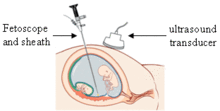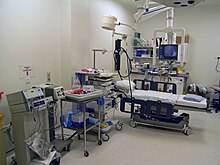Endoscope

An endoscope is an inspection instrument composed of image sensor, optical lens, light source and mechanical device, which is used to look deep into the body by way of openings such as the mouth or anus. A typical endoscope applies several modern technologies including
Etymology
"Endo-" is a scientific Latin prefix derived from ancient Greek ἐνδο- (endo-) meaning "within", and "-scope" comes from the modern Latin "-scopium", from the Greek σκοπεῖν (skopein) meaning to "look at" or "to examine".[3]
History

The first endoscope was developed in 1806 by German physician Philipp Bozzini with his introduction of a "Lichtleiter" (light conductor) "for the examinations of the canals and cavities of the human body".[4] However, the College of Physicians in Vienna disapproved of such curiosity.[5] The first effective open-tube endoscope was developed by French physician Antonin Jean Desormeaux.[6] He was also the first one to use an endoscope in a successful operation.[7]
After the invention of
Hans Christian Jacobaeus has been given credit for the first large published series of endoscopic explorations of the abdomen and the thorax with laparoscope (1912) and thoracoscope (1910)[10] although the first reported thoracoscopic examination in a human was also by Cruise.[11]
Laparoscope was used in the diagnosis of
Georg Wolf, a Berlin manufacturer of rigid endoscopes established in 1906, produced the Sussmann flexible gastroscope in 1911.
Fiber optics
Basil Hirschowitz, Larry Curtiss, and Wilbur Peters invented the first fiber optic endoscope in 1957.[18] Earlier in the 1950s Harold Hopkins had designed a "fibroscope" consisting of a bundle of flexible glass fibres able to coherently transmit an image. This proved useful both medically and industrially, and subsequent research led to further improvements in image quality.
The previous practice of a small filament lamp on the tip of the endoscope had left the choice of either viewing in a dim red light or increasing the light output – which carried the risk of burning the inside of the patient. Alongside the advances to the optics, the ability to 'steer' the tip was developed, as well as innovations in remotely operated surgical instruments contained within the body of the endoscope itself. This was the beginning of "key-hole surgery" as we know it today.[19]
Rod-lens endoscopes
There were physical limits to the image quality of a fibroscope. A bundle of say 50,000 fibers gives effectively only a 50,000-pixel image, and continued flexing from use breaks fibers and so progressively loses pixels. Eventually so many are lost that the whole bundle must be replaced (at considerable expense). Harold Hopkins realised that any further optical improvement would require a different approach. Previous rigid endoscopes suffered from low light transmittance and poor image quality. The surgical requirement of passing surgical tools as well as the illumination system within the endoscope's tube which itself is limited in dimensions by the human body left very little room for the imaging optics.[citation needed] The tiny lenses of a conventional system required supporting rings that would obscure the bulk of the lens' area. They were also hard to manufacture and assemble and optically nearly useless.[citation needed]
The elegant solution that Hopkins invented was to fill the air-spaces between the 'little lenses' with rods of glass. These rods fitted exactly the endoscope's tube making them self-aligning and requiring of no other support.[citation needed] They were much easier to handle and utilised the maximum possible diameter available.
With the appropriate curvature and coatings to the rod ends and optimal choices of glass-types, all calculated and specified by Hopkins, the image quality was transformed even with tubes of only 1mm in diameter. With a high quality 'telescope' of such small diameter the tools and illumination system could be comfortably housed within an outer tube. Once again, it was Karl Storz who produced the first of these new endoscopes as part of a long and productive partnership between the two men.[20]
Whilst there are regions of the body that will always require flexible endoscopes (principally the gastrointestinal tract), the rigid rod-lens endoscopes have such exceptional performance that they are still the preferred instrument and have enabled modern key-hole surgery.[citation needed] (Harold Hopkins was recognized and honoured for his advancement of medical-optic by the medical community worldwide. It formed a major part of the citation when he was awarded the Rumford Medal by the Royal Society in 1984.)
Composition

A typical endoscope is composed of following parts:
- A rigid or flexible tube as a body.
- A light transmission system that illuminates the object to be inpsected. For the light source, it is usually located outside the scope body.
- A lens system that transmits the image from the objective lens to the observer, usually a relay lens system in the case of a rigid endoscope or a bundle of optical fibers in the case of a fiberoptic endoscope.
- An eyepiece which transmits the image to the screen in order to capture it. However, modern videoscopes require no eyepiece.
- An additional channel for medical instruments or manipulators (only for a multi-function endoscope, see below in "Classification").
Besides, patients undergoing endoscopy procedure may be offered sedation in to avoid discomfort.

Clinical application

Endoscopes may be used to investigate symptoms in the
Health care workers can use endoscopes to review the following body parts:
- The gastrointestinal tract:
- Esophagus: chronic esophagitis, esophageal varices, esophageal hiatal hernia, esophageal leiomyoma, esophageal cancer, cardiac cancer, etc.
- tumor.
- Small intestine: small intestine neoplasms, smooth muscle tumors, sarcomas, polyps, lymphomas, inflammation, etc.
- colonic polyps, colorectal cancer, etc.
- The pancreas and biliary tract:
- cholangitis, cholangiocarcinoma, etc.
- The laparoscopy:
- liver disease, biliary disease, etc.
- The respiratory tract:
- lung cancer, transbronchoscopy lung biopsy, selective bronchography, etc.
- The urinary tract:
- ureteral stones, ureteral tumors, etc.
- The ear, nose and throat:
- Ear: tympanitis, inner ear deformity, etc.
- Nose: rhinitis, nasal polyp, etc.
- Throat: retropharyngeal abscess, specific infection, etc.
- Ear:
Classification


There are many different types of endoscopes for medical examination, so are their classification methods. Generally speaking, the following three classifications are more common:
- According to functions of the endoscope:
- single-function endoscope: A single-function endoscope refers to an observation mirror that only has an optical system with it.
- multi-function endoscope: For a multi-functional endoscope, in addition to the function of observation, it also has at least one working channel like lighting, surgery, flushing and other functions.
- According to detection areas reached by the endoscope:
- enteroscope
- otoscope
- colonoscope
- rhinoscope
- arthroscope
- laparoscope
- etc.
- According to rigidity of the endoscope:
- rigid endoscope: A rigid endoscope is a prismatic optical system with advantages of clear imaging, multiple working channels and multiple viewpoints.
- flexible endoscope: A flexible endoscope is an optical-fiber-based system. Notable features of a flexible endoscope include that the lens can be manipulated by the operator to change direction, but the imaging quality is not as good as a rigid one.
Recent developments

With the development and application of robotic systems, especially
- Endoscopy VR simulators
Virtual reality simulators are being developed for training doctors on various endoscopy skills.[24]
- Disposable endoscopy
Disposable endoscopy is an emerging category of endoscopic instruments. Recent developments[25] have allowed the manufacture of endoscopes inexpensive enough to be used on a single patient only. It is meeting a growing demand to lessen the risk of cross contamination and hospital acquired diseases. A European consortium of the SME is working on the DUET (disposable use of endoscopy tool) project to build a disposable endoscope.[26]
- Capsule endoscopy
Capsule endoscopes are pill-sized imaging devices that are swallowed by a patient and then record images of the gastrointestinal tract as they pass through naturally. Images are typically retrieved via wireless data transfer to an external receiver.[27]
The endoscopic images can be combined with other image sources to provide the surgeon with additional information. For instance, the position of an anatomical structure or tumor might be shown in the endoscopic video.[28]
- Image enhancement
Emerging endoscope technologies measure additional properties of light such as optical polarization,[29] optical phase,[30] and additional wavelengths of light to improve contrast.[31]

Non-medical Use
- Industrial endoscopic nondestructive testing technology
The above is mainly about the application of endoscopes in medical inspection. In fact, endoscopes are also widely used in industrial field, especially in non-destructive testing and hole exploration. If internal visual inspection of pipes, boilers, cylinders, motors, reactors, heat exchangers, turbines, and other products with narrow, inaccessible cavities and/or channels is to be performed, then the endoscope is an important, if not an indispensable instrument.[32]
See also
References
- ISBN 9781510622678.
- ^ "Medical Definition of Endoscope". Medicinenet.com. Retrieved 11 August 2017.
- ^ "endoscope". Oxford English Dictionary. Oxford Press.
- ^ Bozzini, Philipp (1806). "Lichtleiter, eine Erfindung zur Anschauung innerer Teile und Krankheiten, nebst der Abbildung" [Light conductor, an invention for examining internal parts and diseases, together with illustrations]. Journal der Practischen Arzneykunde und Wundarzneykunst (in German). 24: 107–24.
- ISBN 978-1-4443-0342-1.
- ^ "Desormeaux, Antonin Jean". EAU European Museum of Urology. Retrieved 2022-06-29.
- S2CID 234747817.
- PMID 2325571.
- ISBN 978-93-86150-49-3.
- PMID 9876654.
- .
- ISBN 978-3-428-00192-7.
- ISBN 978-1-107-32018-5.
- PMID 9876691.
- ^ "About Richard Wolf Germany". Richard Wolf Medical Instruments.
- ^ "Endoscope Biopsy channels". Richard Wolf Medical Instruments.
- ^ Nezhat C (2005). "Chapter 19. 1960's". Nezhat's History of Endoscopy. Society of Laparoendoscopic Surgeons. Archived from the original on 2018-07-27. Retrieved 2016-01-07.
- PMID 2044933.
- PMID 30633227.
- ^ "History". Harold Hopkins Society.
- ^ Staff (2012). "Upper endoscopy". Mayo Clinic. Retrieved 24 September 2012.
- ^ "cooltech.iafrica.com | tech news World first transatlantic robotic surgery". 2007-10-13. Archived from the original on 2007-10-13. Retrieved 2022-06-30.
- ^ "Esophageal pH Test: MedlinePlus Medical Test". medlineplus.gov. Retrieved 2022-06-30.
- ^ "Overview of Endoscopy Haptics Simulator Project". M2D2 Laboratory, Indian Institute of Science. YouTube.
- ^ "Dokument nicht gefunden". Archived from the original on 2011-07-20.
- ^ "Development of a Disposable Use Endoscopy Tool". 2018-03-26. Archived from the original on 2011-07-23.
- ^ "Patient Information". asge.org. Retrieved 2022-07-01.
- YouTube
- PMID 25836165.
- PMID 31840442.
- PMID 21639573.
- ^ "Nondestructive Testing: Endoscopy :: Total Materia Article". www.totalmateria.com. Retrieved 2022-07-02.
